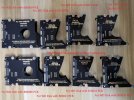The drive is encrypted directly to USB PCB. Swapping the PCB for a SATA board is out of the question.
To recover the data, you will need to read the ROM, modify it to unlock SA access, write it back and hope that it will be enough to access the SA. if SA.
If not, you will need to modify the USB board with a SATA connector and hope that will help get access to the SA.
The odds are, after you get SA access, you will need to backup & repair key SA modules, load them into RAM and hope that is enough to get access to unencrypted data.
However, most of the time, you still end up having to change the heads 2 or 3 times and may still not get access to the data.
Tools needed:
ROM programmer
PC3000 or MRT
Clean room
Head change tools
Donor drives
I'm trying to keep this simple. Did I miss something
@300DDR &
@labtech?
This is it pretty much in nutshell. Perhaps we could add soldering tools and skills for when ROM programmer is iffy and need to manually do swap, as well as solder SATA interface into proper channels.
@
Kerrya
Those easy USB bridge removal and convenient swapping days are pretty much over. Those model drives are pretty much gone and recycled.
Most WD external drives nowadays have multiple issues, especially anything 2017 and newer. On power on, they could sound absolutely normal, but they could still have mechanical issues, firmware issues and bad sectors, of course.
Sometimes you may see a corrupt exFAT partition issue or something trivial, but very rarely.
Also, for the WD 3.5" SATA drives, most also are now SED locked (Self Encryption Drive). Again, cannot swap PCBs, as it won't solve anything. Also, the PCBs are pretty well built nowadays, so they rarely have failures, unless we are talking about electronics issues related to power surges, wrong spec power adapters plugging in, people trying to shuck HDDs from external drives and try to trick the "spin down" setting, and so on.
This also applies to 2018 and newer Seagate & Lacie (also a Seagate product) external drives, which, like WD, have factory based encryption in the hardware.
So, PCBs cannot be swapped and reprogrammed. Matter of fact, powering drives on with a donor PCBs on both WDs and Seagates could cause further firmware damage, which can be a nightmare to resolve. Sometimes it may be impossible to solve.
For Toshiba external drive, they have not yet introduced hardware encryption. But as you have likely seen, Toshibas also have USB integrated interface. Straight PCB will not work with Toshibas either, due to specific/unique firmware parameters stored in the hardware.

